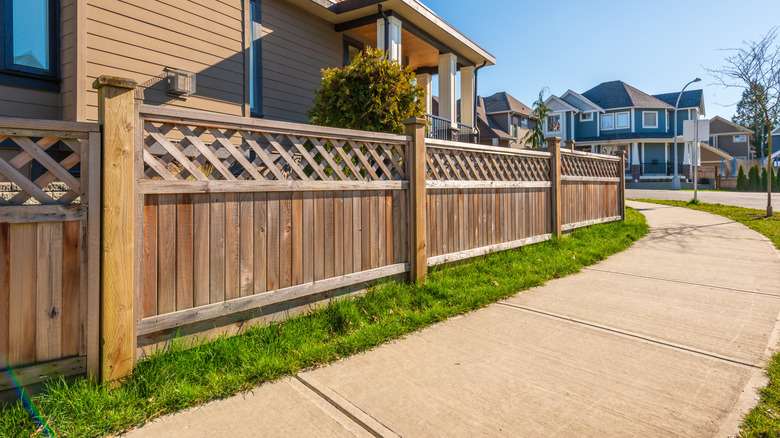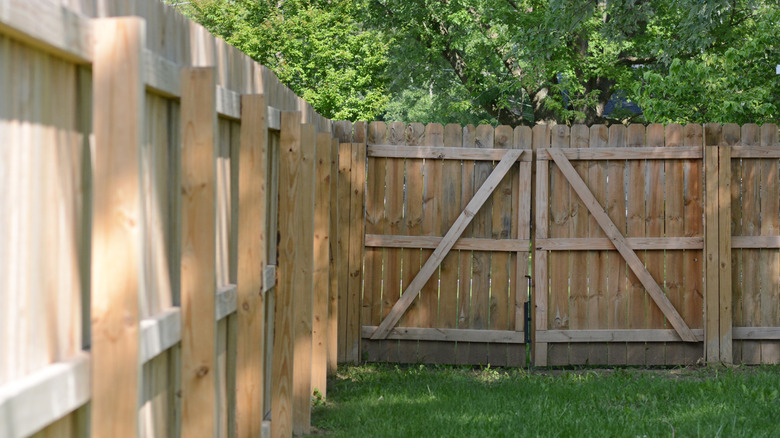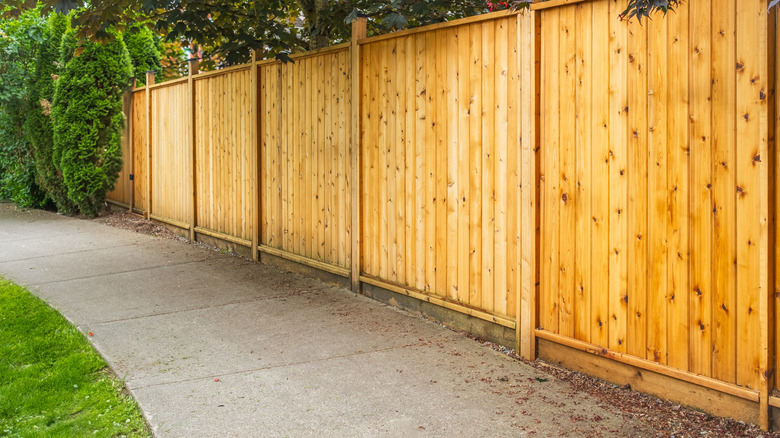The Worst Type Of Wood Fence Material & The Major Downsides To Be Aware Of
Picking the right material is often the hardest part of installing a new fence. Although wood is a timeless classic, many homeowners are stumped when faced by all the options available. If you're currently debating the types of wood for your fence, make your choice easier by eliminating pine. Although pine is a popular option, it is one of the worst fence choices because it doesn't hold up as well to the elements compared to other wood species.
One of the main factors driving pine's popularity is its widespread availability and low cost. Typically, pine fences run $1 to $5 per linear foot. That's huge savings when you compare it to other options, like cedar, that average $8.50 to $9.25 per linear foot or redwood that is $8 to $20 per linear foot. Those savings come at a cost, though. If you opt for pine panels, you run a greater risk of your fence warping or cracking due to the harsh elements.
A number of woods naturally resist rot thanks to their oils, including red and white cedar. This makes them excellent for outdoor use because they can hold up for awhile without any treatment. Pine, however, isn't a species with natural rot resistance. For outdoor use, you can purchase pressure-treated pine that has preservatives forced into its surface to make it more durable. However, pressure-treated fencing has its downside. Plus, the treated pine still only lasts about 15 years. That's not much when compared to other species, like redwood, which can last up to 25 years.
Pine fences can be unattractive and high-maintenance
Durability isn't the only thing to consider when choosing your fencing material. People want a fence that looks good, too. Many are drawn to pine because of its distinct grain pattern and pale yellow tones. Since pine is so light in color, it is also relatively easy to stain or paint, so you can change up the look of your fence if desired. However, pine is super prone to knots. If you're into a rustic look, then knotted wood is the way to go. Others, though, may find it unattractive. Also, be aware that pressure-treated pine may have a green tint upon installation. Although this green will eventually fade, it can take a couple months or years, depending on your environment.
To keep your pine fence looking good, it will also require a lot of maintenance. Like most fences, you need to apply a sealant to prevent damage from the sun, moisture, and other elements. However, pressure-treated fences need to be sealed more frequently, and they require more routine cleaning. You also need to keep a closer eye out for any damaged boards, including those that are bowed, split, or rotten. It may be tempting to skip this maintenance. However, doing so will not only reduce the lifespan of your pine fence but also cause it to discolor from the neglect, turning an unsightly green or black.
Other wood fencing options to consider
While pine fences have their benefits, the cons are hefty. Fortunately, there are a lot of different types of wooden fences to consider at a variety of price points. On the more budget-friendly end, you can look into woods like cypress, spruce, or redwood, which tend to range from $2 to $8 per linear foot. Be aware that spruce also tends to have a short lifespan and is prone to warping in damp environments. On the other hand, treated cypress fences may last up to 25 years and contain natural insect-repelling oils. However, they can be difficult to get ahold of.
For those who are able to invest more in their fence, cedar is an excellent option to explore. Although cedar fencing is considerably more expensive than pine up front, you may save in the long-run due to its durability. Plus, if you're drawn to light-colored woods, you can still achieve that desired look by opting for white cedar over red. If you need help choosing between installing a red or white cedar fence, we've got you covered. And a quick tip: When researching materials, make sure that you are not only considering your price point, but also how your local weather will impact your wooden fence. Knowing which woods hold up well in humidity, rain, or freeze-thaw cycles can save you a lot of headache down the road.


